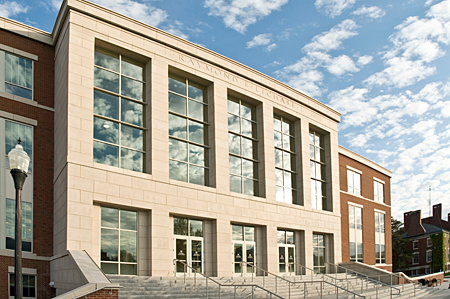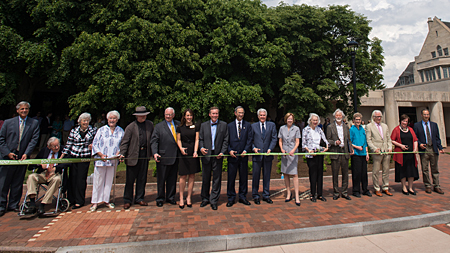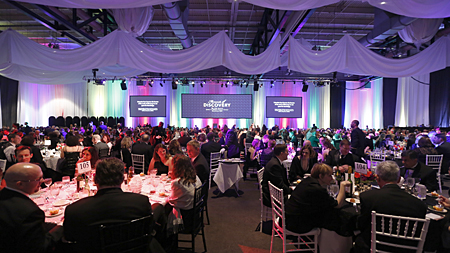Raymond F. LeChase Hall:
A Place to Call “Home”
 Photograph by Andy Olenick
Photograph by Andy Olenick
Over the past 55 years, the Margaret Warner Graduate School of Education and Human Development has carved a place for itself among leading schools of education. Now, 20 years after its naming as the Warner School—in memory of Margaret Warner Scandling ’44 and her deep commitment to teaching and learning, and in recognition of the leadership and generosity of her husband, the late William F. Scandling—the School has a unique place to call “home” at the University.
On May 16, Warner School faculty and staff were joined by dozens of members and leaders of the University community for a moving ceremony to formally dedicate Raymond F. LeChase Hall.
“This project is a reflection of the generosity and support of many individuals in the Warner School and University community, many of whom are here today,” said President Joel Seligman. “From educating future teachers to researching our higher education system, LeChase Hall enhances a wide range of diverse programming at Warner. The LeChase family’s leadership in this project articulates a lifetime commitment to strengthening the University and the community.”
LeChase Hall is the first new building constructed on the Wilson Quadrangle in 30 years, thanks to a generous gift from University Life Trustee R. Wayne LeChase and his wife, Beverly. The gift was made in memory of Wayne’s father, Raymond F. LeChase, who is now the namesake of the new building. “My dad was a very instrumental part of our lives,” said Wayne. “And it’s a great honor for me to pay him tribute in this everlasting manner.”
The building dedication marked a future of new possibilities and an elevated presence on the River Campus for the Warner School. Board Chair Edmund Hajim ’58 aptly defined the occasion as a dream come true for Raffaella Borasi P’12, P’14, dean of the Warner School and Frederica Warner Professor. It wasn’t long ago the School was bursting at the seams with its capabilities at capacity, in Dewey Hall.
“What matters most is LeChase Hall will allow us to invoke the University’s motto ‘ever better,’” said Borasi. “In just the few months that we have been living in this building, we have been able to do things that were never possible before.” Borasi provided the example of the School hosting 55, 10th-grade students from a charter school in the Rochester City School District to give them a sense of what college life is like.
LeChase Hall provides vibrant spaces, filled with light and materials that inspire, for the Warner School’s programs, faculty and staff, and 600 full- and part-time students. With a building to call its own, the Warner School can better pursue the key prongs of its mission: preparing educators to transform schools, communities, and individual lives; researching some of today’s most pressing educational problems to help forge effective solutions; and partnering with the community to address global issues in human development.
To see pictures from the event, click here.
Values and Action

Every October, when our community—near and far—comes together for Meliora Weekend, I think, “There is no better time of year for the University.” But every May, I find myself thinking the same thing.
May 17 began the celebration of our 163rd Commencement Ceremonies that will come to a close on June 9 with the ceremony for the Simon School of Business. When all has been said and done, we will have conferred more than 3,000 bachelor's, master's, and doctoral degrees. For our students, this was a critical step in their lives.
It is not by chance that Learn is the first element in our endeavor to make the world “ever better.” It is upon this foundation that our students will discover, heal, and create. Through the triumphs of our students, I can readily see us succeeding in our mission.
While our commencement ceremonies belong largely to our students, they should be equally meaningful to you—our alumni, parents, and friends. In addition to making a Rochester education more accessible through scholarships, by providing critical support to our faculty through endowed professorships like the Georgia and Thomas Gosnell Distinguished Professor in Palliative Care and the Georgia and Thomas Gosnell Professor in Quality and Safety, you are helping to enhance the quality of our students' education and experience at the University.
This month also saw the dedication of Raymond F. LeChase Hall, made possible by leadership gifts from University Life Trustee R. Wayne LeChase and his wife, Beverly, incoming Trustee Tim Wentworth and his wife, Robin, and Michael Scandling. Just next door, construction continues to progress on Ronald Rettner Hall for Media Arts and Innovation, named to recognize the generosity of University Trustee Ron Rettner. These gifts and the supporting gifts from hundreds of other donors will give Rochester students two magnificent new buildings in which they can pursue their passions and advance these important fields of human endeavor.
If you’re going to be on campus in the near future, be sure to make time to take a tour of LeChase Hall. It’s an amazing building with beautiful features. And in the fall, Rettner Hall will come online in all of its glory. I couldn’t be happier about these additions to campus, and I’m confident you will feel the same.
Meliora!
James D. Thompson
Senior Vice President
Chief Advancement Officer
Celebrating a Milestone for Centennial Sculpture Park
 Members of the Rochester, Memorial Art Gallery, and University communities gather to commemorate a significant moment for the Gallery and its Centennial Sculpture Park.
Members of the Rochester, Memorial Art Gallery, and University communities gather to commemorate a significant moment for the Gallery and its Centennial Sculpture Park.
On May 22, more than 300 special guests gathered for a dedication and ribbon-cutting ceremony at the Memorial Art Gallery’s Centennial Sculpture Park. During the Gallery’s centennial year, this special event marked another step toward the park's completion.
“In dedicating this park on the original campus of the University of Rochester, we celebrate the University’s longstanding commitment to the life of our community,” said President Joel Seligman. “We are pleased as well to be part of a collaboration with the City of Rochester that strengthens the connection between the University’s art museum and the culturally diverse neighborhood that surrounds it.”
The Centennial Sculpture Park is the culmination of many generous gifts from members of the Rochester and University communities. These gifts also provided support to the Memorial Art Gallery’s “Gateways to Art” campaign, an initiative for The Meliora Challenge: The Campaign for the University of Rochester, co-chaired by members of the Memorial Art Gallery’s Board of Managers Andrew Gallina and Charlotte Herrera.
The park’s strategic location and the removal of decades-old wrought-iron fencing have further blended the Memorial Art Gallery into the neighborhood and opened its grounds for public enjoyment. For Grant Holcomb, the Mary W. and Donald R. Clark Director of the Memorial Art Gallery, it is the realization of a vision he had when the project was first announced in 2010.
“The new Centennial Sculpture Park, with its fusion of poetry (Poets Walk), Rochester history (Story Walk), and the visual arts transforms the grounds of the Memorial Art Gallery,” said Holcomb. “It is yet another beautiful and significant park for the community to enjoy.”
Additional remarks were made by James Durfee, president of the Memorial Art Gallery Board of Managers, Thomas Richards, Mayor of the City of Rochester, and Maggie Brooks, Monroe County Executive.
During the ceremony, President Seligman presented Eastman Medals to artists Wendell Castle and Albert Paley. The award is given to individuals whose achievements and service embody the University’s highest ideals. Castle’s “Unicorn Family” has already been installed in front of the Gallery, along with Tom Otterness’s “Creation Myth” and Jackie Ferrara’s “Marking Crossways.” Paley’s “Soliloquy” will be installed near the Goodman Street entrance in August 2013.
In addition to the site-specific installations, Centennial Sculpture Park showcases works from the Gallery’s collection by such noted artists as Deborah Butterfield, Todd McGrain, Nancy Jurs, Beverly Pepper, George Rickey, Tony Smith, and Mary Taylor.
To see pictures from the event, click here.
Quill and Panzer Installed as Gosnell Professors
 From left: Joel Seligman, Thomas Quill, Georgia Gosnell, Robert Panzer, Bradford Berk, and Mark Taubman
From left: Joel Seligman, Thomas Quill, Georgia Gosnell, Robert Panzer, Bradford Berk, and Mark Taubman
The Palliative Care and Quality and Safety Programs are vital to the University of Rochester Medical Center’s mission of providing “Medicine of the Highest Order” and creating patient- and family-centered care environments. Timothy Quill ’76M (MD), ’79M (Res), ’81M (Flw) and Robert Panzer ’80M (Res), ’82M (Flw) have championed the University’s efforts in these areas, producing exceptional results.
On May 22, Quill, director of the University’s Palliative Care Program, was installed as the inaugural Georgia and Thomas Gosnell Distinguished Professor in Palliative Care; Panzer, chief quality officer for the Medical Center and Strong Memorial Hospital, was installed as the inaugural Georgia and Thomas Gosnell Professor in Quality and Safety. A ceremony at the Country Club of Rochester honored the professors’ achievements and the leadership and generosity of their benefactors, Georgia Gosnell and her late husband, Thomas.
“Georgia and Tom have shown incredible support at the Medical Center and in so many other parts of the University and throughout the Rochester community,” said President Joel Seligman. “We benefit from their generosity at the Memorial Art Gallery, the George Eastman House, and the Rochester Philharmonic Orchestra; they have strengthened our city, and we are enormously grateful to them.”
The Gosnells are among Rochester’s most philanthropic families. In addition to the areas mentioned by President Seligman, the Gosnells have given to the Rochester Institute of Technology, the Al Sigl Center, and the Genesee Land Trust. Georgia also recently made a major commitment to the Neonatal Intensive Care Unit in the new Golisano Children’s Hospital.
The Georgia and Thomas Gosnell Professorships will help take two programs that are already nationally recognized to the next level. Palliative care is not just end-of-life care or hospice care. Palliative care is designed to provide patients with relief from physical and emotional suffering and improve the quality of life for patients and their families. “We owe Tim a great debt of gratitude,” said Mark Taubman, dean of the School of Medicine and Dentistry and University vice president for Health Sciences. “His work has helped define palliative care—not just at the Medical Center, but all over the country and all over the world.”
Dr. Timothy Quill has published and lectured widely about various aspects of the doctor-patient relationship, with special focus on end-of-life decision making. In addition to authoring several books on palliative and end-of-life care, he has written numerous articles for major medical journals. Quill is considered to be among the leaders in his field by many of his peers and health care providers.
Patient safety is a cornerstone of excellence in health care and one of the top priorities at the Medical Center. “At times when quality is questioned it can be easy to say the data is wrong; we know better,” said Taubman. “Bob recognizes that is not the right answer. In order to be the best, we need a champion, and that’s what he has been for us.”
Dr. Robert Panzer is also associate vice president for patient care quality and safety for the Medical Center and associate medical director of Strong Memorial Hospital. He is actively involved with national networks and organizations focused on continuous quality improvement. As chair for a statewide workgroup to redesign hospital incident reporting, he helped develop the New York Patient Occurrence Reporting and Tracking System.
Endowed professorships are among the highest honors the University can give a faculty member. They are also the most enduring. Donors who establish these positions create a legacy that is linked to and perpetuates excellence in health care.
Fighting Cancer through Moments of Discovery
 14th annual Discovery Ball at the Rochester Riverside Convention Center
14th annual Discovery Ball at the Rochester Riverside Convention Center
Every idea, every advance, every innovation begins with a moment of discovery. More than 950 grateful patients, University faculty and staff, and friends of the James P. Wilmot Cancer Center gathered in support of those moments on May 11 for the 14th annual Discovery Ball at the Rochester Riverside Convention Center. This year’s ball raised a net total of $550,000.
The evening’s program, chaired by Jeffrey and Patrice Pierce, encouraged attendees to “join” the Cancer Center’s research team by supporting seed-grants for new and innovative cancer research initiatives. This effort accounted for $215,000 in cash pledges. With every table’s commitment, a novelty champagne bottle was uncorked, showering the Convention Center’s Empire Ballroom with rainbow confetti.
Addressing attendees, President Joel Seligman noted that with the Wilmot Cancer Center’s physical infrastructure in place, it is time to focus on the people and programs that make it a world-class cancer treatment facility. A focus on research and broadening the scope of care throughout the region begins with the visionary leadership of Jonathan Friedberg, M.D., Samuel E. Durand Chair and director of the Wilmot Cancer Center.
“For first-rate patient care and cancer research to thrive in Rochester, support from the community is critical,” said Friedberg. “Cancer is not an easy target, and we know that cooperative efforts are the key to successful research and patient care.”
Georgiana Zicari, this year’s Inspiration Award honoree, had a simple message to those attending the Discovery Ball: “Cancer can be beat.” And she would know; she has done it twice. At age 14 she was diagnosed with Hodgkin’s lymphoma and then, thyroid cancer at age 27. With these battles behind her, she now helps others do the same, having volunteered at pediatric oncology clinics and at Camp Good Days and Special Times. Zicari has also lobbied for Congress to increase funds supporting the fight against cancer.
The Discovery Ball is the single largest fundraiser for the Wilmot Cancer Center. Commitments made throughout the evening, will help fund the development of more effective treatments, new preventions and, ideally, cures for cancer.
To see pictures from the event, click here. To view the video shown at the event, click here.